
Refer to PSP 19th Perihelion Campaign page.
2024-03-29 (CSV, PDF table of coordinates)
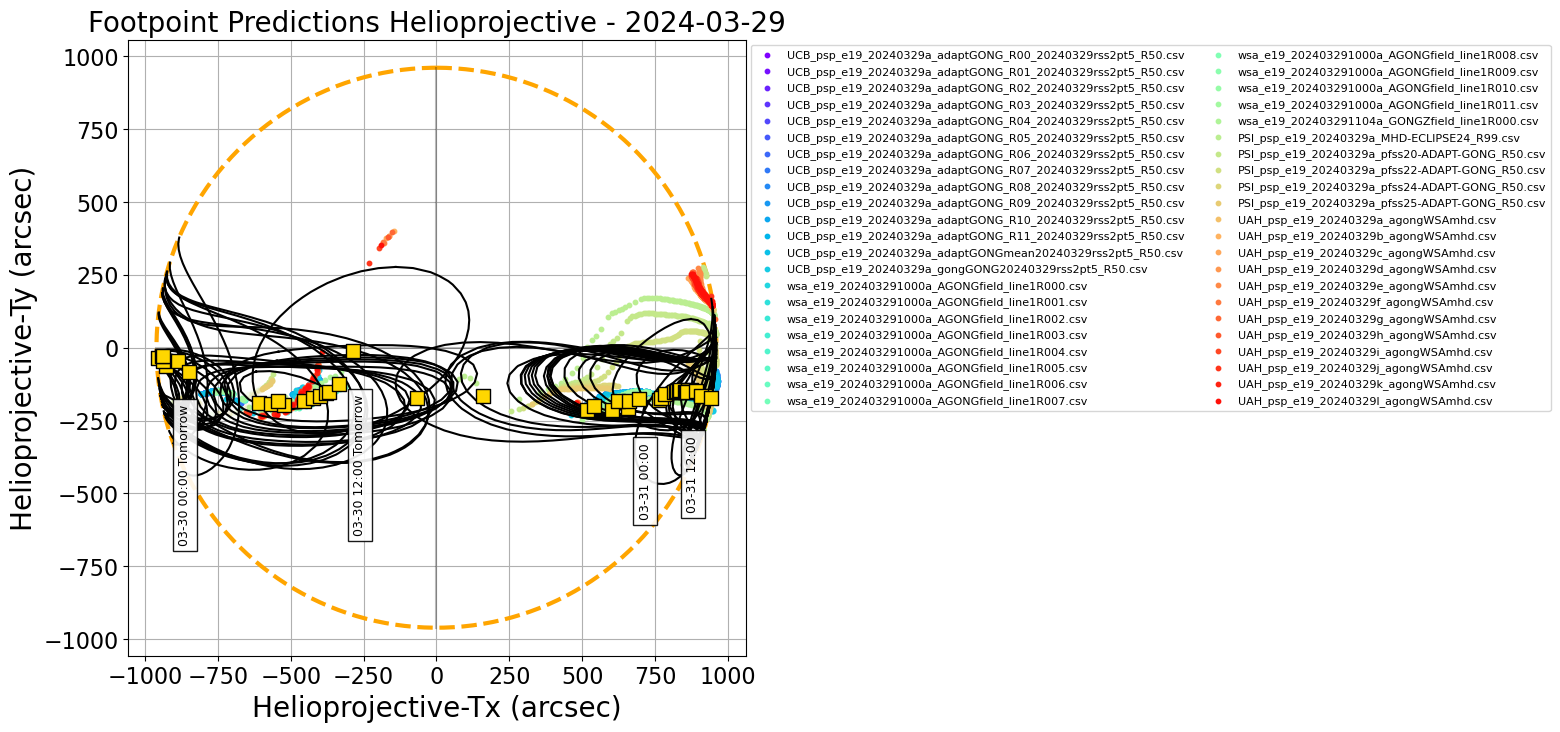
Figure 1.
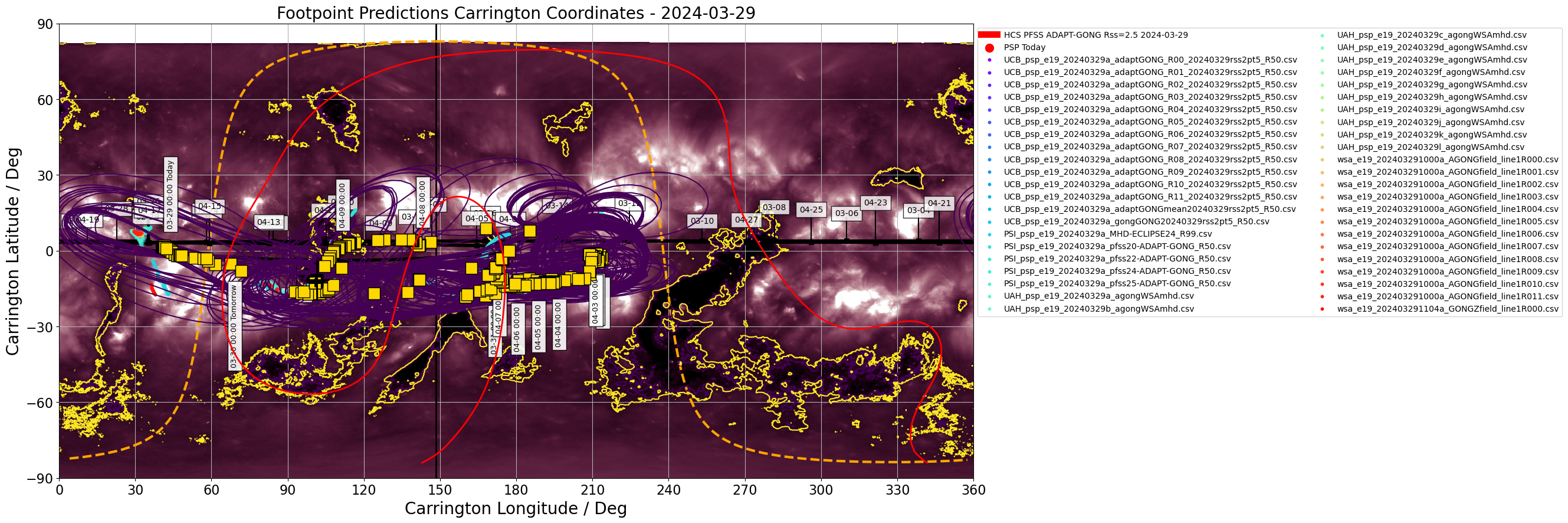
Figure 2.
Figures above show one footpoint per day plotted on the solar disk and in Carrington coordinates (click on figure to zoom and see caption).
The predicted footpoints were kindly provided by the PSP 19th Perihelion modeling team.
Encounter 19 Prediction update (1/5): 2024/03/29
This is the first of 5 daily footpoint predictions issued for Parker Solar Probe Encounter 19, reaching 11.4Rs at perihelion on 03/30 0200UT. We expect the spacecraft magnetic footpoints to sweep the whole way across the solar disk from the East to the West limb starting later today and crossing behind the limb around the end of March 31st.
Magnetic Connectivity
---------------------
Footpoints are expected to migrate on disk over the east limb around 1900 UT today 3/29 and move extremely rapidly across the disk towards the West limb at a consistent latitude. The mapping is generally mid-latitude and equatorial, at first moving along the south active region band around -15 degrees latitude, touching on an equatorial coronal hole around 100 degrees longitude (close to the longitude which will be in the plane of the sky on the west limb during the April 8th eclipse), before jumping across the heliospheric current sheet and continuing to track along mid-southern latitude active regions and coronal holes. We expect this jump to be around 03/30 1400UT. Motion from this point starts to decelerate with west limb passage occurring around 1700 UT on 03/31.
Flare Likelihood (CCMC Flare Scoreboard)
----------------------------------------
Based on forecasts on the CCMC flare scoreboard, moderate flaring is quite possible, with C-, M-, and X-class flares having a 24-hour probability of 86, 33, and 11%. These may, in turn, result in SEP events at Parker, and elsewhere.
Eclipse Comment:
----------------
During the total solar eclipse visible from much of the US on April 8th, Parker's nominal connectivity will be behind the limb. However, during this perihelion it will pass over the solar wind sources that will be in the West limb plane of the sky during the eclipse. Currently, this longitude corresponds to the equatorial coronal hole the predictions map to for 03/30 1200 UT. Further, observers should note that if a CME is observed from the West limb during the eclipse it is likely to encounter both Parker and Solar Orbiter.
*** Please note that the "arrival time" and "emission time" and associated Tx/Ty coordinates for both are reported in the consensus CSV file. The attached plots show the "arrival time" (location of source at time that plasma will arrive at PSP).
See https://docs.google.com/presentation/d/1mz02FU24vqKxxLRaJlyScfAh8gB07iOlBsTHApvhls8/edit#slide=id.p for some discussion on these***.
2024-03-30 (CSV, PDF table of coordinates)
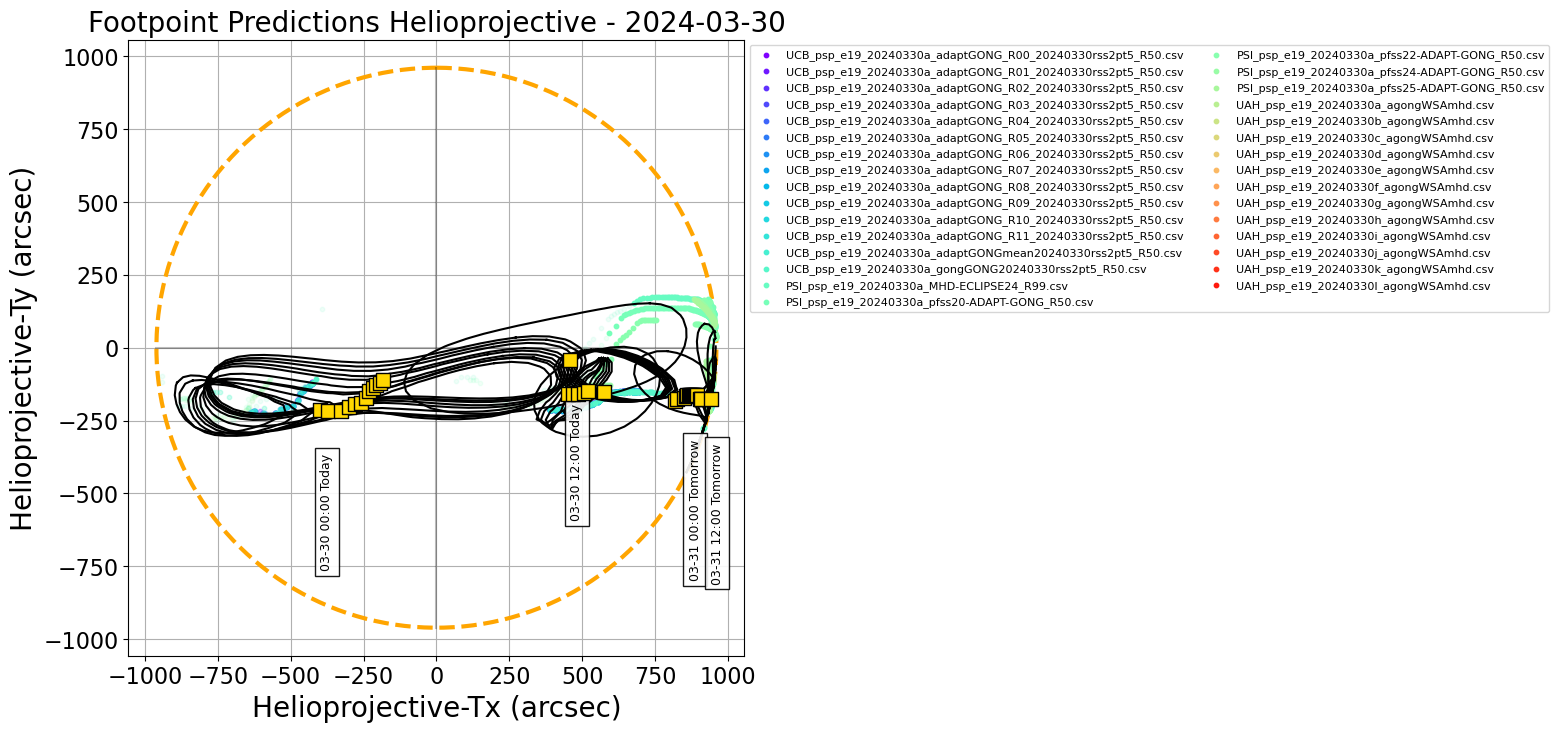
Figure 1.

Figure 2.
Figures above show one footpoint per day plotted on the solar disk and in Carrington coordinates (click on figure to zoom and see caption).
The predicted footpoints were kindly provided by the PSP 19th Perihelion modeling team.
Encounter 19 Prediction update (2/5): 2024/03/30
This is the second daily footpoint prediction issued for Parker Solar Probe Encounter 19, reaching 11.4Rs at perihelion earlier today 03/30 0200UT. The spacecraft magnetic footpoints are now on disk and migrating rapidly westwards, crossing behind the West limb around the end of March 31st.
Magnetic Connectivity
---------------------
Predictions remain stable from yesterday. Mapping 3/30 until 1700 UT is on an equatorial coronal hole just eastwards of disk center (close to the longitude which will be in the plane of the sky on the west limb during the April 8th eclipse). After this the mapping jumps across the heliospheric current sheet and continuing to track along mid-southern latitude active regions and coronal holes. Motion from this point starts to decelerate. The west limb passage time moves earlier in today's update, occurring potentially as early as 1200 UT on 03/31.
Flare Likelihood (CCMC Flare Scoreboard)
----------------------------------------
The flare probabilities derived from the Flare Scoreboard indicate a high likelihood of minor-intensity solar flare activity within a 24-hour forecasting window (99% for C-class flares). Conversely, the probability for M-class flares stands at 14%, suggesting a moderate likelihood of more significant flare events. The forecast also indicates a 4% probability of X-class flares, which, although low, signifies a non-negligible risk of potentially severe space weather events. As of 1700 UT today no CME eruptions have been reported in the CCMC CME scoreboard database within the last two days. There remain 5 NOAA-tracked active regions on the disk, all lying west of central meridian (while Parker will be connected to the Eastern hemisphere).
Eclipse Comment
----------------
During the total solar eclipse passing over much of the US on April 8th, Parker's nominal connectivity will be behind the limb. However, during this perihelion it will pass over the solar wind sources that will be in the West limb plane of the sky during the eclipse. Currently, this longitude corresponds to the equatorial coronal hole the predictions map to for the middle of today, 03/30 1200 UT (before the posting of these predictions). Further, observers should note that if a CME is observed from the West limb during the eclipse it is likely to encounter both Parker and Solar Orbiter.
*** Please note that the "arrival time" and "emission time" and associated Tx/Ty coordinates for both are reported in the consensus CSV file. The attached plots show the "arrival time" (location of source at time that plasma will arrive at PSP). See https://docs.google.com/presentation/d/1mz02FU24vqKxxLRaJlyScfAh8gB07iOlBsTHApvhls8/edit#slide=id.p for some discussion on these***.
2024-03-31 (CSV, PDF table of coordinates)
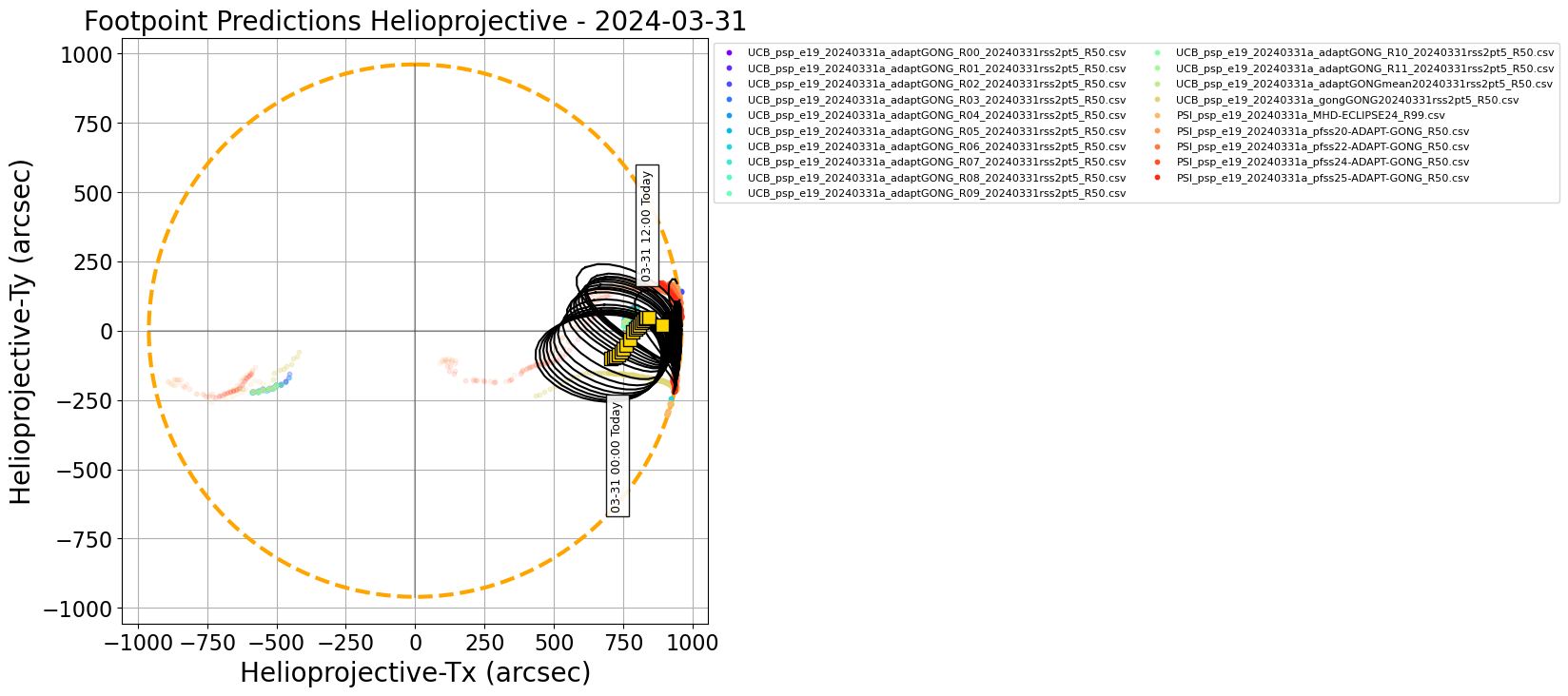
Figure 1.

Figure 2.
Figures above show one footpoint per day plotted on the solar disk and in Carrington coordinates (click on figure to zoom and see caption).
The predicted footpoints were kindly provided by the PSP 19th Perihelion modeling team.
Encounter 19 Prediction update 3: 2024/03/31
This is the third daily footpoint prediction issued for Parker Solar Probe Encounter 19, reaching 11.4Rs at perihelion yesterday 03/30 0200UT. The spacecraft magnetic footpoints are now approaching the West limb and are likely to map to sources off the visible disk by the end of today.
Magnetic Connectivity
---------------------
Footpoints are predicted to be connected near the West limb very near the equator amidst active region bands. We predict they will migrate off the limb by 5pm UT today (3/31). This will be confirmed in a further update tomorrow and as a result no update will be provided on Tuesday 4/2.
Flare Likelihood (CCMC Flare Scoreboard)
----------------------------------------
The flare probabilities derived from NASA's CCMC Flare Scoreboard again indicate a reasonably high likelihood of minor-to-moderate-intensity solar flare activity within a 24-hour forecasting window (70% for C-class flares and 14% for M-class flares). In contrast, the forecast indicates a 0% probability of X-class flares, suggesting that severe events are not expected from the observable solar disk over the next 24 hours. As of 1700 UT today no CME eruptions have been reported in the CCMC CME scoreboard database within the last three days. There are five NOAA-numbered active regions on the disk, four lying to the west of central meridian, and a new one northeast of central meridian. NOAA active region 13615 that hosted some intense flare activity in previous days has just rotated beyond the western limb.
Eclipse Comment:
----------------
During the total solar eclipse passing over much of the US on April 8th, Parker's nominal connectivity will be behind the limb. However, during this perihelion it will pass over the solar wind sources that will be in the West limb plane of the sky during the eclipse. Currently, this longitude corresponds to the equatorial coronal hole the predictions mapped to yesterday, 03/30 1200 UT. In tomorrow's final update we will provide a comment on how this region has been evolving since this time. Further, observers should note that if a CME is observed from the West limb during the eclipse it is likely to encounter both Parker and Solar Orbiter.
*** Please note that the "arrival time" and "emission time" and associated Tx/Ty coordinates for both are reported in the consensus CSV file. The attached plots show the "arrival time" (location of source at time that plasma will arrive at PSP). See https://docs.google.com/presentation/d/1mz02FU24vqKxxLRaJlyScfAh8gB07iOlBsTHApvhls8/edit#slide=id.p for some discussion on these***.
2024-04-01 (CSV, PDF table of coordinates)
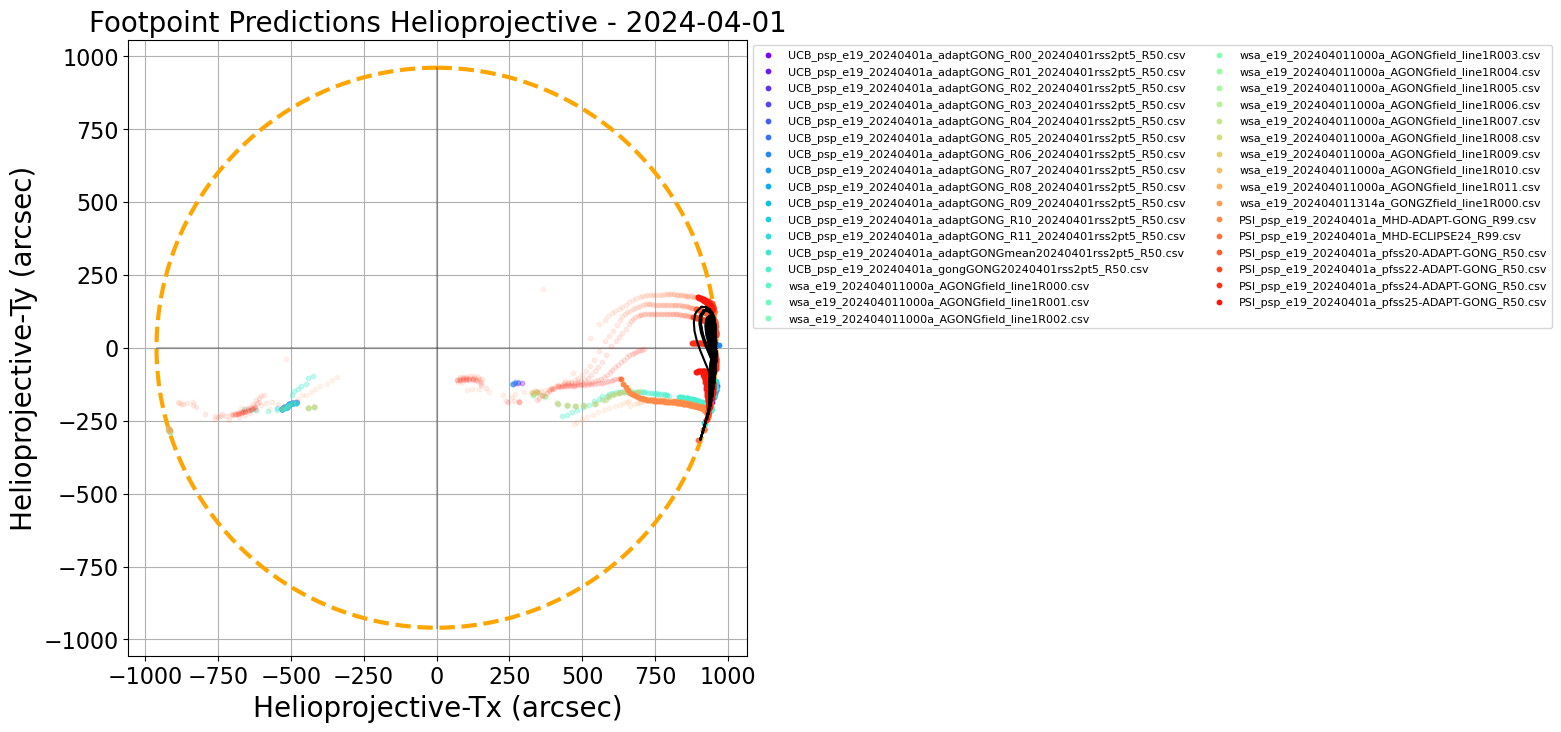
Figure 1.

Figure 2.
Figures above show one footpoint per day plotted on the solar disk and in Carrington coordinates (click on figure to zoom and see caption).
The predicted footpoints were kindly provided by the PSP 19th Perihelion modeling team.
Encounter 19 Prediction update 4: 2024/04/01
This is the final daily footpoint prediction issued for Parker Solar Probe Encounter 19, which reached 11.4Rs at perihelion two days ago 03/30 0200UT. The spacecraft magnetic footpoints are now likely behind the West limb. Observations of sources near the equatorial part of the limb may still contribute to solar wind measured by Parker for the rest of the day.
Magnetic Connectivity
---------------------
Predictions suggest that the connectivity is just behind the limb. Parker has now entered its corotation interval so its longitude is not changing rapidly. Therefore observers may be interested to continue to monitor near-equatorial west limb locations for the next couple of days, particularly as there are active regions located there currently too (see below).
Flare Likelihood (CCMC Flare Scoreboard)
----------------------------------------
The flare probabilities derived from NASA's CCMC Flare Scoreboard today suggest a high likelihood of minor-to-moderate-intensity solar flare activity within a 24-hour forecasting window (90% for C-class flares and 13% for M-class flares), including a low, 2% probability of X-class flares, suggesting a slight risk for severe events over the next 24 hours. As of 1700 UT today, no CME eruptions have been reported in the CCMC CME scoreboard database within the last four days, however. There are six NOAA-numbered active regions on the disk, five lying to the west of central meridian and one northeast of central meridian. The newest, NOAA active region 13625, emerged north of the equator, on the western limb.
Eclipse Comment:
----------------
During the total solar eclipse passing over much of the US on April 8th, Parker's nominal connectivity will be behind the limb. However, during this perihelion it will pass over the solar wind sources that will be in the West limb plane of the sky during the eclipse. Currently, this longitude corresponds to the equatorial coronal hole the predictions mapped to around perihelion on 03/30 1200 UT, prominently visible near disk center at the time of the posting: https://sdo.gsfc.nasa.gov/assets/img/browse/2024/04/01/20240401_132011_1024_0211.jpg. Since this time, this coronal source has remained stable and continues to corotate towards the West limb where it will be on April 8th. Observations made near the equatorial regions off the West limb during the eclipse may therefore be related to near-perihelion in situ data taken by Parker Solar Probe, although fore and back-ground active region plasma will likely be projected into the same plane of sky location too. Further, observers should note that if a CME is observed from the West limb during the eclipse it is likely to encounter both Parker and Solar Orbiter.
*** Please note that the "arrival time" and "emission time" and associated Tx/Ty coordinates for both are reported in the consensus CSV file. The attached plots show the "arrival time" (location of source at time that plasma will arrive at PSP). See https://docs.google.com/presentation/d/1mz02FU24vqKxxLRaJlyScfAh8gB07iOlBsTHApvhls8/edit#slide=id.p for some discussion on these***.
Date and arrival time of plasma parcel at PSP, consensus carrington longitude (deg), latitude (deg), error in longitude, error in latitude, on-disk position of predicted source in X and Y (arcseconds) at arrival time, date and emission time of plasma parcel at the source, on-disk position of predicted source at time parcel is emitted. Each row is the updated source location each hour.
The consensus is generated by forming a distribution of footpoint predictions from all modelers for each hour period, and attempting to fit a Kent distribution. If the fitting fails, the median in longitude and latitude are quoted. If the fitting is successful, the quoted errors are formed by drawing random samples from the fitted distribution and computing the standard deviation in longitude and latitude of those samples. If the fitting fails, the quoted errors are the standard deviation in the longitude and latitude from the raw distribution of predictions. The full shape of the distribution is described by black contours in the associated plots on this website. More details about the procedure can be found at the following preprint of Badman et al. (2023) "Prediction and Verification of Parker Solar Probe Solar Wind Sources at 13.3Rs"
Please note the carrington coordinates (lon,lat) are valid from the quoted timestamp (in UTC) until the next timestamp. The helioprojective coordinates quoted (HP-Tx, HP-Ty) are computed from the carrington coordinate at the quoted timestamp (e.g. midnight UTC each day) and so are valid instantaneously at this time but will corotate with the Sun until the next quoted timestamp. For a discussion of the subtle difference in emission and arrival time and why both are included please see the slide deck.
Individual model prediction tables of coordinates may be found in a Public DropBox. Files in the Public DropBox have three-letter identifiers indicating the associated model (see below).
Three-letter designation for Public DropBox: UCB. Kindly provided by Sam Badman. The model is a simple ballistic propagation from PSP down to the source surface assuming slow wind 360km/s, and then tracing this sub-PSP trajectory through a PFSS model to get footpoints at the photosphere. The source surface height here is 2.5Rs. The PFSS model is generated using various ADAPT maps with GONG and HMI as input, and the model is run using the open source pfsspy package. A more detailed explanation of the model and comparison to PSP E1 results are given here.
Three-letter designation for Public DropBox: PSI. Kindly provided by Pete Riley. For these predictions, PSI is using a combination of modeling approaches, including PFSS solutions, empirically-based polytropic MHD solutions, and a more sophisticated approach that includes the effects of waves and turbulence to heat the corona and the WKB approximation for wave pressures to accelerate the solar wind. Additionally, boundary conditions are derived from both HMI and ADAPT synoptic magnetograms. Together, these allow us to generate a rich set of ensemble realizations from which to make our optimal prediction, as well as pool them with other teams’ forecasts to derive a hyper-ensemble prediction.
Three-letter designation for Public DropBox: wsa. Kindly provided by Shaela Jones. The Wang-Sheeley-Arge (WSA) model is a combined empirical and physics-based model of the corona and solar wind. The coronal portion of the Wang-Sheeley-Arge (WSA) model is comprised of the Potential Field Source Surface (PFSS) and Schatten Current Sheet (SCS) models, where the output of the PFSS model serves as input to the SCS model. The solar wind portion of WSA consists of a simple 1-D kinematic propagation code that takes stream interactions into account in an ad-hoc fashion. It provides predictions of the solar wind speed and interplanetary magnetic field IMF polarity at any specified point in the inner heliosphere. The WSA model can use global maps of the photospheric magnetic flux measurements from a number of sources as its inner boundary condition; here we are using an ensemble of maps from the Air Force Data Assimilative Photospheric Flux Transport (ADAPT) model, based on input GONG magnetograms.
UAH predictions come from the University of Alabama, Huntsville Multiscale Fluid-Kinetic Simulation Suite (MS-FLUKSS, Pogorelov et al. (2014); Pogorelov (2023); Singh et al. (2022)), which can solve the Reynolds-averaged ideal MHD equations for the mixture of thermal and nonthermal solar wind ions coupled with the kinetic Boltzmann equation describing the transport of neutral atoms. An adaptive mesh refinement technique can be employed for efficient high-resolution calculations. The MS-FLUKSS heliospheric MHD model is coupled with the WSA model (Kim et al., 2020), which uses both ADAPT-GONG and ADAPT-HMI input magnetograms, with the PFSS source surface height and the WSA outer boundary at 2.5 and 10 solar radii, respectively. Hence, field line tracing is performed through the MHD domain down to 10 solar radii instantaneously at approximately 1 hour cadence, where the origin of the field line on the photosphere is already known, as described for WSA.
see Prediction and Verification of Parker Solar Probe Solar Wind Sources at 13.3Rs, Badman et al. (2023)